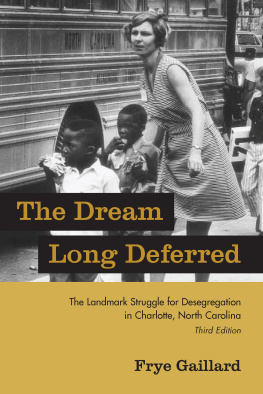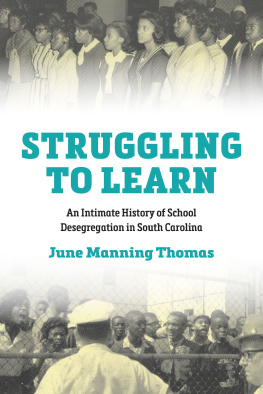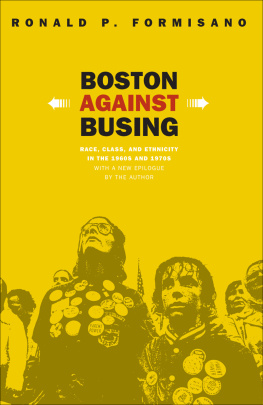Reading, Writing, & Race
1995 The University of North Carolina Press
All rights reserved
Manufactured in the United States of America
The paper in this book meets the guidelines for permanence and durability of the Committee on Production Guidelines for Book Longevity of the Council on Library Resources.
Library of Congress Cataloging-in-Publication Data
Douglas, Davison M.
Reading, writing, and race: the desegregation of the
Charlotte schools / Davison McDowell Douglas.
p. cm.
Includes bibliographical references (p. ) and index.
ISBN 0-8078-2216-7 (alk. paper).
ISBN 0-8078-4529-9 (pbk.: alk. paper)
1. School integrationNorth CarolinaCharlotte
Case studies. I. Title.
LC214.23.C43D68 1995
370.19342dc20 94-39347
CIP
99 98 97 96 95 5 4 3 2 1
Publication of this volume was aided by a generous grant from the Z. Smith Reynolds Foundation.
THIS BOOK WAS DIGITALLY MANUFACTURED.
To my parents
JOHN MUNROE DOUGLAS
&
MARJORIE LUTZ DOUGLAS
who taught me the value of education
Contents
Challenging Separate and Unequal Education in
North Carolina before Brown
Illustrations
Billingsville School, Grier Heights neighborhood, Charlotte, 1951
Dorothy Counts at Harding High School, September 4, 1957
Protesting students await Dorothy Counts, September 4, 1957
Gus Roberts at Central High School, September 4, 1957
Reginald Hawkins campaigning for governor, May 1968
Civil rights attorney Julius Chambers, 1981
Rally expressing outrage at bombings, November 28, 1965
School Board Chair William Poe, October 1967
Editor C. A. McKnight and associate editors, September 1971
Judge James McMillan and John Finger, December 4, 1969
Antibusing protester outside U.S. courthouse, December 4, 1969
School buses are prepared for the opening of school, September 1970
Students in northwest Charlotte ride school bus, February 1972
Police officers subdue two students following disturbance, October 1972
Adult volunteer helps children at Hidden Valley Elementary, September 1970
West Charlotte high school students welcome students from Boston, October 1974
Acknowledgments
I received a tremendous amount of support along the way in writing this book. The staff of the following libraries were most helpful in allowing me to use their manuscript collections: the Special Collections at the University of North Carolina at Charlotte, the Public Library of Charlotte and Mecklenburg County, the Southern Historical Collection and the North Carolina Collection at the University of North Carolina at Chapel Hill, the North Carolina State Archives in Raleigh, and the Manuscripts Division of the Library of Congress in Washington, D.C. In addition, the Charlotte Observer graciously opened its files to me, as did the Charlotte-Mecklenburg Community Relations Committee. The Charlotte-Mecklenburg Public Schools, the Charlotte Chamber of Commerce, and the United States Courthouse in Charlotte also provided valuable assistance. Carlton Watkins and Paul Ervin, Jr., allowed me to examine their personal papers. The library staff and administration at the William and Mary Law School were particularly supportive of my research efforts. I am also very grateful to the National Endowment for the Humanities and the William and Mary Law School, both of which provided me with generous financial support.
Many people assisted me in this project. My two dissertation advisers at Yale University, John Blum and John Butler, each gave me a great deal of critical encouragement and support at various stages of my work. Drew Days, Neal Devins, Steven Gillon, David Goldfield, Paul LeBel, William Link, Michael Okun, Rodney Smolla, Mark Tushnet, and Stephen Wasby each read earlier drafts of the book and offered valuable criticism. Ellen Ferris, Erin Hawkins, Jonathan Koenig, John McGowan, Joan Pearlstein, Manesh Rath, and Stephen Schofield tirelessly and cheerfully helped me track down endless newspaper articles and cases.
I would also like to thank the staffs of the Northwestern University Law Review and the Chicago-Kent Law Review. Chapter 2 first appeared in revised form in the fall 1994 issue of the Northwestern University Law Review. Parts of chapters 3 and 4 first appeared in the spring 1995 issue of the Chicago-Kent Law Review.
At the University of North Carolina Press, executive editor Lewis Bate-man, editor Pamela Upton, and copyeditor Teddy Diggs each provided valuable encouragement and assistance and greatly strengthened the book.
Mike and Melva Okun, Peggy Link, and Steve Evans graciously opened their homes to me during my many research trips. Dozens of participants in the events described in this book shared their recollections and insights with me, greatly enriching my understanding of desegregation in Charlotte.
Finally, I must note that I attended the Charlotte-Mecklenburg Schools from 1962 until 1974 and hence experienced firsthand many of the events described in this book. To my friends-both black and whitein the Class of 1974, I give thanks for your courage and faithfulness through a trying time. I hope this book in some small way will enhance our understanding of what those years were all about.
Reading, Writing, & Race
Introduction
Race, today as much as ever, is the American dilemma. For over three centuries, since a Dutch ship brought twenty Africans to Jamestown in 1619, America has struggled with the question of how to square the oppressive treatment of African Americans with the American credo of equality under law. For most of this nations history, white society has maintained legal superiority over African Americans. Until the Civil War, the ownership of black slaves enjoyed legal protection throughout the American South. Although the wars conclusion carried with it the promise of freedom, that promise proved hollow. A system of enforced racial separation in various aspects of public and private life emerged during the last quarter of the nineteenth century and persisted until the 1950s and 1960s. Although by the early 1960s, most of the explicit government-mandated segregation had been eliminated, the legacy of centuries of discrimination left the nation dividedeconomically, culturally, and even geographicallyalong racial lines.
Since the end of the Civil War, the African American community in this country has struggled to secure for itself the promise of equality seemingly guaranteed by the Fourteenth Amendment to the U.S. Constitution. Those efforts enjoyed little success, however, until the middle decades of the twentieth century. White state legislatures and school boards consistently viewed demands for equal treatment as unwanted intrusions into the southern way of life. At the same time, the African American community lacked sufficient resources and power to challenge the racial status quo. The courts, the one institution specifically committed to the vindication of constitutional rights, offered little relief to black litigants until the middle of the twentieth century.
Since the 1940s and 1950s, however, there has been a profound reordering of the legal and social order in this country around issues of race. Indeed, the civil rights movement of the 1950s and 1960s constituted one of the most significant social and political readjustments in this nations history. Scholars have differed over the primary impetus for these changes. Many have focused on the role of national civil rights leaders, such as Martin Luther King, or the actions of national civil rights organizations, such as the National Association for the Advancement of Colored People (NAACP), the Congress of Racial Equality (CORE), the Southern Christian Leadership Conference (SCLC), and the Student







